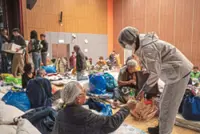A sweeper cleaning as smog envelops the area and reduces visibility in Lahore, Pakistan. — AP
MOST of the world has dirty air, with just 17% of cities globally meeting air pollution guidelines, a recent report found.
Switzerland-based air quality monitoring database IQAir analysed data from 40,000 air quality monitoring stations in 138 countries and found that Chad, Congo, Bangladesh, Pakistan and India had the dirtiest air.





